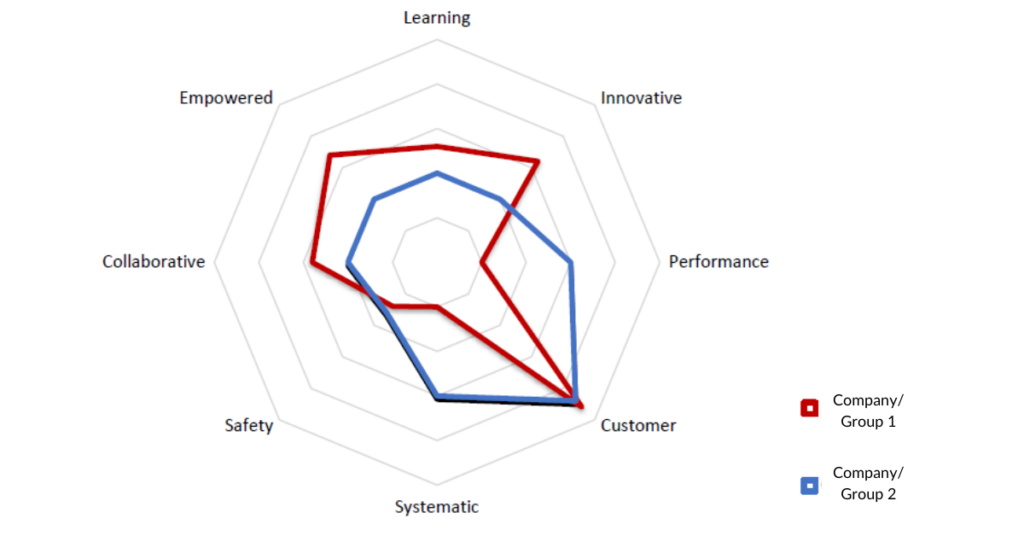There’s a quote that you’ve probably heard a thousand times about culture and strategy from Peter Drucker: “Culture eats strategy for breakfast.” Up until the pandemic, I would have agreed 1000% about this quote; but lately more and more companies come to Velocity for culture help, only for us to uncover their overall business strategy is in disarray.
I am convinced more than ever that you can’t tackle your culture if you don’t know where you are going.
Let’s look at some examples.
Company A: Global telecommunications organization, primarily based in Europe. They owned a large percentage of cable fiber in the U.S. and Europe and purchased companies that could provide cable/internet and VOIP to customers in local markets. At the time, Company A had 27,000 employees and was looking at more acquisition.
Looming through all of this was a desire to rewrite their values and tackle the culture they were building. After months of interviews, focus groups, and consultant support, they were ready to launch a new campaign. Two weeks before launch, an announcement came out that they were selling 1/3 of the business in the next 12 months. Leadership decided that they still wanted to launch this massive culture undertaking and the tag line they had come up with to anchor all this work fell massively flat. The companies that were being sold didn’t resonate with it and the companies remaining were not sure what their future ultimately held for them. All this work to energize and reinvigorate their culture was drastically overshadowed by a strategy change—and the two didn’t align.
Company B: A company who invested in corporate real estate pivoted to a new strategy during the pandemic. Wanting to set the tone for newly acquired organizations in their portfolio, they started with Blue Sky thinking—what kind of culture do we want to create? There was a lot of excitement and energy around rewriting values, competencies, behavior, and what would make someone shine at the newly formed entity lost momentum quickly because how the business operated had changed. What they were supporting was new, different, and hard to wrap arms around.
Every time a culture initiative came up for launch, it was quickly tabled because of larger strategic shifts that were taking place. It wasn’t that Company B didn’t care about the culture, but quickly realized they couldn’t build the culture when they were still building their strategy.
Company C: A newly acquired entity was undergoing a shift in the way they worked. They wanted to bring sub-departments closer together and align on becoming a unified entity within the larger company. As part of that alignment, they needed to tap into each group and see what culturally needed to stay and what needed to change: What commonalities did they have and what pitfalls would they experience if they changed or took away things as they combined?
After weeks of interviews and research, it became very clear it would be hard to recommend any culture change or transformation when there was lack of clarity on what the departments were going to look like in a newly combined entity. The strategy of the group was still being defined, and without that strategy it was hard to definitely say what culturally they were striving to do or be. Without the business strategy, the culture could go nowhere.
Strategy + Culture = Engaged, Productive Employees
This isn’t to say that these companies didn’t or can’t turn around their culture, but when you start reflecting on culture without a clear understanding of why the company exists and what it wants to achieve, the culture will become stagnant (if it isn’t already). People won’t derive energy from the work they do and the people they support in the same way as in cultures that are thriving and everyone is working towards the same goals.
One of the most interesting stats that came out in the pandemic on company engagement and cultures was that engagement of thriving cultures sustained in 2020 & 2021, while engagement in non-thriving cultures declined 52% *.
There are a lot of factors that go into what defines a culture as thriving, but a few that we see in our clients include:
- Psychological safety amongst the teams and leaders—employees feel heard, safe to show up as their true authentic self, and can push back on ideas or tasks
- Employees LOVE the mission of the company and the work they get to do every day
- There is limited drama and a collective understanding that you address the elephant in the room vs tip-toeing around it
- There is alignment on the leadership team of the strategy and direction in which the company is headed
- There one culture that shines through the company vs. silos and independent cultures (that often are formed with misalignment of goals and strategic objectives)
A Powerful New Tool for Bringing Cultures Together
This is a hot topic right now for many of our clients, and our new Culture Archetype Matrix offers a new way to look at strategy and culture together. Layering in validated research, we’re able to help clients see where their culture currently lies and what differences might exist between that and where they want to go.

While the emphasis on this tool is around where a culture leans, it’s heavily supported in the dialogue with leadership teams by how it aligns to the overall business strategy. Sometimes the answer is yes, and sometimes it’s a great moment to pause and really ask: are we supporting our people the way we need to, to get them aligned in the direction we need them to go? This is especially powerful when we look at companies that are acquiring new businesses, divesting divisions, and/or pivoting their go-to-market strategy. Is where they want to go going to be a big enough shift that the culture will be impacted?
The Culture Archetype Matrix offers a unique solution in that it assesses the organization’s culture across six organizational dimensions and can be done alongside an annual culture engagement survey or as a stand-alone project with the whole company or with just the leadership team.
It’s a simple solution that can solve a complex organizational problem. Often what the data tell us is compelling enough to make lasting and impactful change.
Curious how your culture and strategy connect? Reach out today.
* OC Tanner Global Engagement Report 2021


